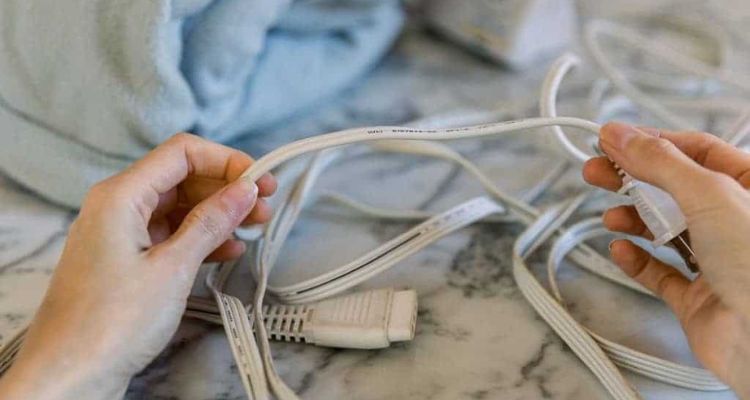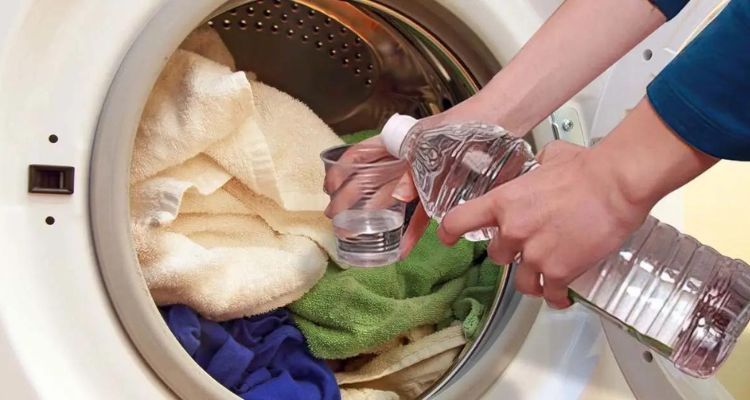We all enjoy a warm cozy blanket that protects us from the shivering cold winds outside. Nothing is more comforting as you hide underneath it and wrap it tightly around you. The only disturbing part pitches in is the flashing current and sparks that follow you as you try to get comfortable. It is not dangerous but not welcome. It especially is worse as the weather becomes colder and dryer.
But no worries, as there are several ways to eliminate this unpleasant guest. Let’s look at how you can still enjoy the night.
What Causes Static Charge in the Objects?
When two objects come in contact with each other and are then separated, a flow of charge creates an imbalance. It renders electrical charges at the surfaces of the objects. These events are triboelectric charges, also called static or contact charges.

The phenomenon creates sparks in your blanket and can be the reason for more powerful lightning.
Normally, objects remain balanced because the atoms that make them up have an equal number of electrons (negatively charged) and protons (positively charged).
Still, the balance is disturbed when they rub against other objects. It is because electrons transfer from the surface of one to another, making one negatively charged while the other is positive. However, they quickly try to recover from this disturbed state, and the built-up of electrons is moved to the next object in contact.
You will feel an electric shock if you walk on the carpet and touch a metal door knob, for example. It is because carpet, an insulator, removes electrons from the body, making it positive. It causes the electrons from the metal to flow toward your body, causing the surfaces to be charged and you to feel the sensation.
This effect is more pronounced in winter when dry air and moisture levels are low. It allows for a better flow of charges on slight friction, leading to the demonstration of static electricity.
Which Materials Are Prone To Static Electricity?
Every object is built differently. While conductors, which are most metals, allow an easy flow of electrons. Unless they are isolated, the charges distribute evenly. While insulators resist the charge movement and are more prone to the buildup of static charges.
Materials that readily allow for the flow of charges are:
- Wool: A fiber that is natural and has a tendency to build up charge particles.
- Hair has similar properties to wool.
- Silk
- Polyester is very dry, so even slight friction can cause charges to flow.
- Nylon, tissue paper, plastic wrap, and dry skin are all prone to the accumulation of charges on their surfaces.
Methods to Remove Static from Blankets
Introduce Humidity
Static electricity and the humidity levels of the surrounding air are interconnected. The moisture in the air determines how much charge is built up on the surfaces.
When two objects come into contact, it allows for the transfer of charged particles from one to the other. The buildup of charges is prominent, especially if the object is an insulator and the air is dry and low in humidity.
The surfaces become more conducive with increased humidity levels since the water particles can conduct electricity. The charges will no longer be trapped, evenly distributed through the moisture, and carried far away. It causes a thin layer of water particles on the surface of each object, preventing charge accumulation.
The room’s humidity levels should increase to prevent the blanket from causing sparks
There are ways to do so.
- Using a humidifier is one of the simplest ways. It is convenient and cost-effective and does the job nicely. You can add fragrant oils so that your room smells fresh.
- Use a wet towel and put it before a fan or hang it. It will allow the moisture to spread around, helping to reduce the static.
- Lastly, boil some water slowly and let it sit.
Allow Your Blanket to Hang Dry
It is preferable that you dry your blankets not in the dryer but outside in the air on a clothesline. It reduces the charge buildup and keeps it smelling fresh and new.
Hang drying is a preventive measure that minimizes the chances of letting charge transfer. The major cause of static electricity is the friction force. This force between objects pulls the particles and causes an imbalance in their neutral forms.
Drying the blanket in the dryer means immense friction as it rubs against itself and the walls of the dryer. It will ultimately lead to the sparks as the blanket discharge.
Letting it hang dry keeps the forces at a minimum, especially in materials prone to building up static.
Wash Your Blanket with Vinegar
The sound of using vinegar to wash blankets might be odd and even terrifying for some because of its strong smell. But, in reality, it is a great way to reduce the static that is haunting your sleep.
Normally, many fabric softeners have ingredients that reduce static, keep the cloth fresh, and are amazingly pleasant to smell. But to some, these softeners are damaging. They ruin your blankets.
As an alternative, vinegar is helpful. Since only a small amount is used per batch, you don’t have to worry about an unwanted smell. In addition, vinegar can help break down any odors in the fabric, keeping it clean.
Vinegar, being slightly acidic, works to soften and loosen up the fibers. As a result, it minimizes the friction built up, leading to less charge motion and reducing static in your blanket.

Apply Lotion to Your Body
A lotion can somehow prevent static. However, this remedy works great to avoid the potential friction in an area that causes the accumulation of electrostatic discharge. Applying moisturizer to dryness is among the simplest methods to achieve this in cold weather. As the chilly, dry weather makes electrons more readily movable.
As you apply moisturizer to your skin, the surface humidity of the skin increases. Therefore, there is less buildup of charge that may bind with your blanket, which may irritate you, ensuring hassle-free sleep.
The lotion will act as a protective layer to stop static electricity from gathering on the skin. One should keep the palms hydrated because they are the ones that touch things often. Have some drops of lotion to cover your hands, legs, and maybe even your hair in little amounts. Then carefully brush your clothing to remove shocks from those areas elsewhere too.
You can use an ionizer to restore the equilibrium of lost electrons in space and avoid the formation of static electricity.
So, don’t forget to replenish your body with a good moisturizer after your next bath.
Discharge Blanket with a Metal Hanger
Metals are a good way to prevent static discharge since they are good conductors of electricity. Metals can easily carry away the fixed charge produced in a blanket.
Any electrons clinging to your body will pass through the metal and away, preventing the “jumping” phenomenon that makes a shock. Conductive materials can assist your blankets in recovering to an electrically neutral state, so they won’t surprise you by discharging static electricity.
Blankets serve as the top layer of comfort for a soothing sleep on your mattress, but if static charges surround it, your rest can be troublesome, leaving you awake the whole night.
Before ever utilizing the blankets, you should discharge any electricity that may have built up in them due to static ions. Just pass a metal hanger or other electrically conductive item over the blanket to restrain the unnecessary buildup of charges. A static-free blanket will safeguard your cold winter mornings.
Change Your Drying Cycle
Since the development of the tumbler dryer, static electricity in dryers has posed a problem for the textile industry.
When you dry clothes, they brush together as they twirl and spin in the washer. It enables the fabric to pick electrons from the one with weaker attraction to them. The humidity offers a conductive conduit for them to return to the original fabric as long as the materials contain sufficient moisture.
For example, a static charge never develops in damp linen, but as the fabric dries, the build-up intensifies. The fixed charge amplifies as the fabric’s ability to retain moisture decreases.
The longer you continue the drying, the more intensive the phenomenon will be. Over-drying can make the fabric more prone to clinging to the electrons. You can prevent it by shortening the drier time by a few minutes or, if possible, using the air-dry setting.
Alternatively, by the end of each cycle, you can lightly water spray a piece of clothing and throw it in the dryer. A little bit of moisture provides a conductive surface to remove the static. Try using fabric softeners. They loosen the tension in fibers reducing friction and thus helping prevent static build-up.
Key Takeaways
What Causes Static Charge in the Objects?
Static charge occurs when two objects come in contact, creating an imbalance of electrical charges on their surfaces. This phenomenon can lead to sparks and static electricity.
Which Materials Are Prone To Static Electricity?
Materials that resist the flow of charges, such as wool, hair, silk, polyester, nylon, tissue paper, plastic wrap, and dry skin, are prone to static electricity buildup.
Methods to Remove Static from Blankets
There are several methods to eliminate static from blankets:
- Introduce Humidity: Increase room humidity with a humidifier or wet towel to reduce static buildup.
- Allow Your Blanket to Hang Dry: Hang drying blankets minimizes friction and reduces static.
- Wash Your Blanket with Vinegar: Vinegar softens fibers, reduces friction, and minimizes static.
- Apply Lotion to Your Body: Moisturizing your skin reduces static buildup and irritation.
- Discharge Blanket with a Metal Hanger: Pass a metal hanger over the blanket to remove static charges.
- Change Your Drying Cycle: Shorten dryer time, use the air-dry setting, or lightly spray clothes with water to prevent static in the dryer.
Conclusion:
You cannot deny that a small amount of electricity runs inside your body. So, there is constantly an accumulation of static currents.
These static charges shouldn’t significantly affect your life, but they can be annoying when you jump into bed. The ideal chaos of electrostatic electricity arises when dry weather and blankets unite.
To prevent static electricity in your sheet as soon as the dry or winter season strikes, give one of the tips a shot and break the resistance in your restful sleep.
Resources:
https://www.reference.com/science-technology/humidity-affect-static-electricity
https://faculty.wcas.northwestern.edu/infocom/Ideas/static.html
https://www.americanscientist.org/article/what-creates-static-electricity
How to get static out of blanket FAQs
How Do You Get Static Out Of A Blanket Without A Dryer Sheet?
You can test out several ways to get rid of static, such as using aluminum foil. To help prevent static cling and retain items segregated, roll a few sheets of aluminum foil into a ball with your hands and add them to your washing. Other ways can include using wool, dry balls, or adding baking soda during cycle wash.
What Cancels Out Static?
Grounding can help to avoid the buildup of excessive static charge on objects. It indicates a path for the static charge to move to the ground using a conductive material. It prevents the accumulation of electrostatic discharge.
Why Does My Blanket Spark At Night?
Seeing sparks as you try to cuddle underneath your blanket is funny. The sting and jolts you feel are also irritating. As you tumble dry your blanket, charges build up in it. When the air is dry, the static current cannot be dissipated in the air and accumulates. The type of fabric plays a role over here. Synthetic fibers and wool are more likely to be charged. It is only released when your skin comes in contact with a blanket, and you see the sparks.
Can A Blanket Catch Fire From Static Electricity?
Any remote ignition won't have enough strength to ignite a dry substance like your bedding. Except for a brief jolt to the cheek or ear, it is not hazardous to the body.
There is no flammable substance between the static and the fabric, like gas at a petrol station or chemical vapors in an industrial facility.

